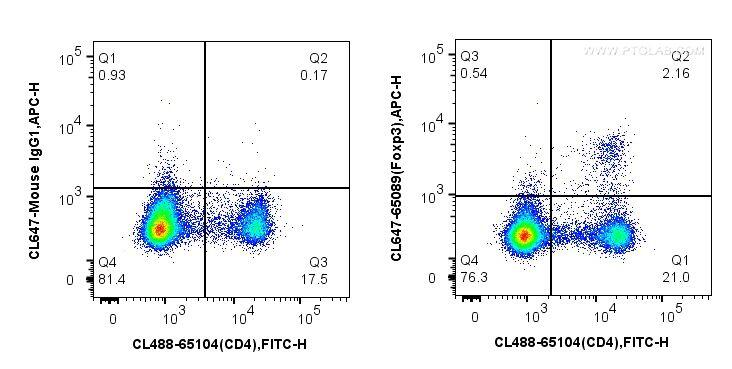- Phare
- Validé par KD/KO
Anticorps Monoclonal anti-PABPN1
PABPN1 Monoclonal Antibody for FC (Intra)
Hôte / Isotype
Mouse / IgG1
Réactivité testée
Humain, rat, souris
Applications
FC (Intra)
Conjugaison
CoraLite® Plus 488 Fluorescent Dye
CloneNo.
3C12E12
N° de cat : CL488-66807
Synonymes
Galerie de données de validation
Applications testées
| Résultats positifs en cytométrie | cellules HeLa |
Dilution recommandée
| Application | Dilution |
|---|---|
| Flow Cytometry (FC) | FC : 0.40 ug per 10^6 cells in a 100 µl suspension |
| It is recommended that this reagent should be titrated in each testing system to obtain optimal results. | |
| Sample-dependent, check data in validation data gallery | |
Informations sur le produit
CL488-66807 cible PABPN1 dans les applications de FC (Intra) et montre une réactivité avec des échantillons Humain, rat, souris
| Réactivité | Humain, rat, souris |
| Hôte / Isotype | Mouse / IgG1 |
| Clonalité | Monoclonal |
| Type | Anticorps |
| Immunogène | PABPN1 Protéine recombinante Ag27470 |
| Nom complet | poly(A) binding protein, nuclear 1 |
| Masse moléculaire calculée | 33 kDa |
| Poids moléculaire observé | 50-56 kDa |
| Numéro d’acquisition GenBank | BC010939 |
| Symbole du gène | PABPN1 |
| Identification du gène (NCBI) | 8106 |
| Conjugaison | CoraLite® Plus 488 Fluorescent Dye |
| Excitation/Emission maxima wavelengths | 493 nm / 522 nm |
| Forme | Liquide |
| Méthode de purification | Purification par protéine G |
| Tampon de stockage | PBS avec glycérol à 50 %, Proclin300 à 0,05 % et BSA à 0,5 %, pH 7,3. |
| Conditions de stockage | Stocker à -20 °C. Éviter toute exposition à la lumière. Stable pendant un an après l'expédition. L'aliquotage n'est pas nécessaire pour le stockage à -20oC Les 20ul contiennent 0,1% de BSA. |
Informations générales
Poly(A) Binding Protein Nuclear 1(PABPN1) is one of the isoforms of poly(A) binding protein (PABP) that locating to the nucleus in eukaryotic cells. And PABPN1 plays important role in mRNA stability by regulating of poly-A tail length, mRNA decay and proximal polyadenylation site (PAS) utilization at the 3'-UTR (PMID:23300856). Another report showed that PABPN1 shuttles between the nucleus and the cytoplasm to export poly(A) RNA from the nucleus (PMID:23601051). It is reported that PABPN1 is ubiquitously expressed in almost all tissues, however, mutations in PABPN1 causes Oculopharyngeal Muscular Dystrophy (OPMD) which affected in skeletal muscles specifically. Because of a mild reduction in PABPN1 levels is sufficient to induce muscle wasting (PMID:27152426). Acetylation, Methylation, Phosphoprotein are common post-translational modifications of PABPN1 protein. And 50-55 kDa bands have been reported (PMID: 29939290; 28361972).
Protocole
| Product Specific Protocols | |
|---|---|
| FC protocol for CL Plus 488 PABPN1 antibody CL488-66807 | Download protocol |
| Standard Protocols | |
|---|---|
| Click here to view our Standard Protocols |



